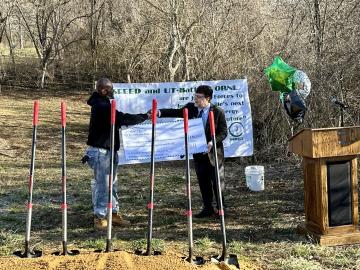
Filter News
Area of Research
Date
News Topics
- 3-D Printing/Advanced Manufacturing (16)
- Advanced Reactors (3)
- Artificial Intelligence (26)
- Big Data (13)
- Bioenergy (11)
- Biology (13)
- Biomedical (6)
- Biotechnology (6)
- Buildings (15)
- Chemical Sciences (18)
- Clean Water (4)
- Climate Change (23)
- Composites (7)
- Computer Science (25)
- Critical Materials (7)
- Decarbonization (22)
- Education (1)
- Emergency (1)
- Energy Storage (11)
- Environment (22)
- Exascale Computing (7)
- Fossil Energy (3)
- Frontier (8)
- Fusion (6)
- Grid (9)
- High-Performance Computing (17)
- Isotopes (12)
- ITER (1)
- Machine Learning (9)
- Materials (15)
- Materials Science (18)
- Mathematics (4)
- Microelectronics (2)
- Microscopy (2)
- Nanotechnology (2)
- National Security (21)
- Net Zero (6)
- Neutron Science (12)
- Nuclear Energy (11)
- Partnerships (17)
- Physics (6)
- Polymers (5)
- Quantum Computing (11)
- Quantum Science (13)
- Security (2)
- Simulation (14)
- Space Exploration (3)
- Statistics (2)
- Summit (6)
- Sustainable Energy (20)
- Transportation (12)
Media Contacts

Since 2019, a team of NASA scientists and their partners have been using NASA’s FUN3D software on supercomputers located at the Department of Energy’s Oak Ridge Leadership Computing Facility to conduct computational fluid dynamics simulations of a human-scale Mars lander. The team’s ongoing research project is a first step in determining how to safely land a vehicle with humans onboard onto the surface of Mars.

Chuck Greenfield, former assistant director of the DIII-D National Fusion Program at General Atomics, has joined ORNL as ITER R&D Lead.

Two different teams that included Oak Ridge National Laboratory employees were honored Feb. 20 with Secretary’s Honor Achievement Awards from the Department of Energy. This is DOE's highest form of employee recognition.

Students with a focus on building science will spend 10 weeks this summer interning at ORNL, the National Renewable Energy Laboratory and Pacific Northwest Laboratory as winners of the DOE’s Office of Energy Efficiency and Renewable Energy’s Building Technologies Office sixth annual JUMP into STEM finals competition.

A team that included researchers at ORNL used a new twist on an old method to detect materials at some of the smallest amounts yet recorded. The results could lead to enhancements in security technology and aid the development of quantum sensors.

Lieutenant Commander Rich Harvey has spent the last three decades of his career serving his country. Harvey's efforts supporting the Office of Naval Research has earned him the 2023 Junior Scientist Officer of the Year award for coordination and computer modeling support for a project called TALISMAN, his leadership roles and other exemplary service markers.

To capitalize on AI and researcher strengths, scientists developed a human-AI collaboration recommender system for improved experimentation performance.

Oak Ridge National Laboratory’s managing contractor, UT-Battelle, presented a donation of $186,000 to Socially Equal Energy Efficient Development, or SEEED, to support the nonprofit’s third green solar home as part of their Green Construction Program.

ORNL scientists and researchers attended the annual American Geophysical Union meeting and came away inspired for the year ahead in geospatial, earth and climate science.

Chelsea Chen, a polymer physicist at ORNL, is studying ion transport in solid electrolytes that could help electric vehicle battery charges last longer.


